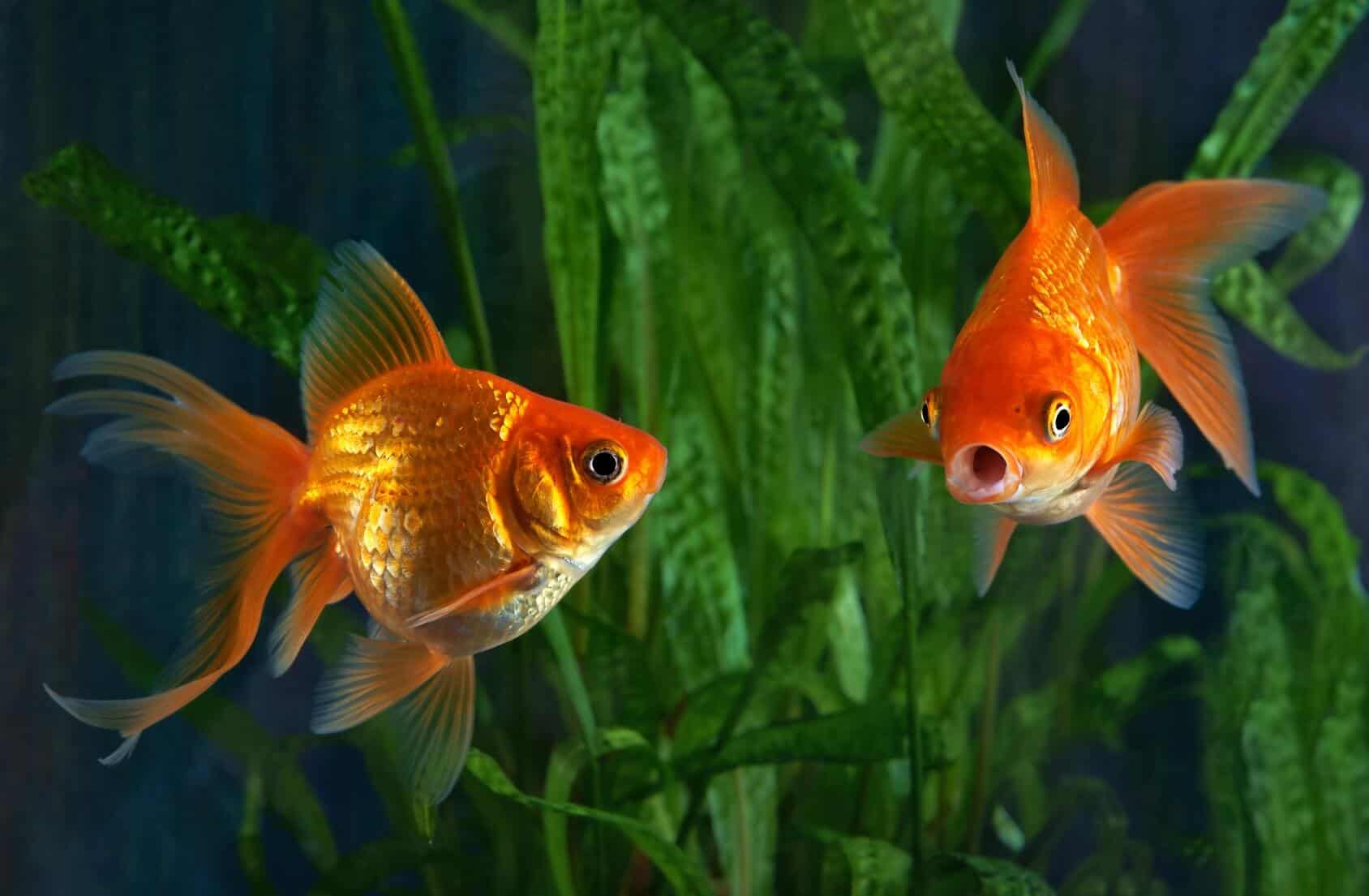Often Overlooked
Fancy Goldfish Long, flowing fins, amazing color patterns and prominent features differentiate these fancy goldfish from the common 'Comet Goldfish.' They do not grow as large as koi, making them a very popular fish for aquariums, smaller ponds and water gardens. Ideal Water Temperature for a Goldfish Aquarium Unlike tropical fish, goldfish prefer cooler water with 65-75°F being ideal. Avoid setting up the aquarium where it will be exposed to a close heat source like a fireplace or direct sunlight for more than a few hours per day.
Among the most common fish in the aquarium hobby, goldfish belong to the Family Cyprinidae and are native to Eastern Asia. They are not the same, but related to carp, and were first domesticated from food fish in China over 1,000 years ago. Goldfish can be distinguished from koi and common carp by the absence of barbels or “whiskers” in the corners of their mouth. Through selective breeding, many “fancy” goldfish strains sporting different body shapes, colors and fin types are available today. They include comets, shubunkins, fantails, orandas, ryukins, moors, telescope eyes, celestial eyes, bubble eyes, butterfly tails, pearlscales, wakins, lionheads, ranchus and many more. Orandas, lionheads and ranchus develop a crown of fatty tissue, called hood growth, over their heads that in mature fish may completely cover their eyes! Fancy goldfish can become stunningly beautiful and command high prices. All varieties of goldfish are the same species – Carrassius auratus. When properly cared for, goldfish can live over 20 years in captivity.

Natural Habitat for Goldfish
Goldfish are ubiquitous in nature and can be found in rivers, streams, lakes, ponds, reservoirs and virtually every freshwater habitat on the planet from temperate to tropical environments. They have been introduced to many parts of the world to control mosquito populations.
Goldfish Water Requirements
Considered cold water fish, goldfish can also be kept in heated aquariums. The optimum temperature for fancy goldfish is 68° to 74° F, while comets and shubunkins should be kept between 60° and 70°F. pH is not critical, but ideally should be between 7.0 and 8.4. Rapid changes in temperature or water chemistry can be harmful, if not fatal to goldfish. A tablespoon of aquarium or sea salt per 5 gallons can also be used to help keep goldfish in good health. Maintain good filtration and change 10% of the water weekly or 25% every 2 weeks using an Aqueon Aquarium Water Changer or Siphon Vacuum Gravel Cleaner. Don’t forget to treat tap water with Aqueon Water Conditioner before refilling your aquarium!
Housing Requirements for Goldfish
Goldfish should never be kept in bowls, small aquariums or any unfiltered container! In addition to having relatively high oxygen demands, they grow to be quite large and generate a significant amount of waste, which can be harmful if allowed to accumulate. Common goldfish, comets and shubunkins make excellent outdoor pond fish and are known to survive relatively cold winters. Fancy goldfish, such as orandas, ryukins, moors and others, can also be kept in outdoor ponds, but are more vulnerable to predators and must be brought in during winter in harsh climates. In aquariums, adult common goldfish, comets and shubunkins should have at least 20 gallons of water per fish, while adult fancy goldfish should have at least 10 gallons per adult fish. The filter should be slightly over-sized to accommodate high waste production and additional aeration is recommended when goldfish are kept at warmer temperatures. Larger goldfish will eat many types of live plants, with the possible exception of Cryptocorynes, Java fern and Anubias, although they may uproot these, too. Avoid decorations with sharp edges and abrasive rocks such as lava and tufa, which may tear delicate fins as well as eye sacs on bubble eyes, celestial eyes, moors and telescopes. Goldfish like to forage in the substrate, so avoid jagged or crushed glass gravel. Provide adequate water flow but avoid strong currents.
Goldfish Behavior/Compatibility
Goldfish get along well with most peaceful, similarly sized fish. Fin nippers and boisterous fish should be avoided. If housed without a heater, they should be kept with other fish that are tolerant of cooler water temperatures. They are gregarious, meaning they like to hang around together. They are intelligent, have long memories and can become very tame. They can be taught to hand-feed and interact with their owners. They can also distinguish their owners from other humans. Goldfish of different sizes can be kept together, however, commons, comets and shubunkins may become too boisterous for smaller fancy goldfish as they grow and may need to be separated. Always consult an aquarium expert before adding any new fish to your aquarium.

What Do Goldfish Eat?
Goldfish are omnivores, feeding largely on crustaceans, insects and plant matter in the wild. A combination of Aqueon Goldfish Flakes, Goldfish Granules and Goldfish Color Granules will provide a high-quality diet. Frozen and live foods, including hornwort plant, can also be given as treats. Goldfish are naturally bottom feeders and may gulp air when feeding at the surface, causing them to lose equilibrium and float upside down. To avoid this, soak flake foods briefly before feeding and avoid the use of floating pellets. For best results, rotate your fishes’ food daily and feed only what they can consume in 2 to 3 minutes, once or twice a day.
Goldfish Breeding - Intermediate
Goldfish Aquarium Kit
Goldfish are egg scatterers and are known to spawn in home aquariums. They provide no parental care after the eggs are laid. Eggs are adhesive and can be seen clinging to plants and other decorations. To prevent eggs from being eaten by the adults or other fish in the aquarium, plants and other objects they are attached to can be moved to a separate aquarium where they will hatch in 48 to 72 hours.
Goldfish Aquarium Ph

Goldfish Aquarium
